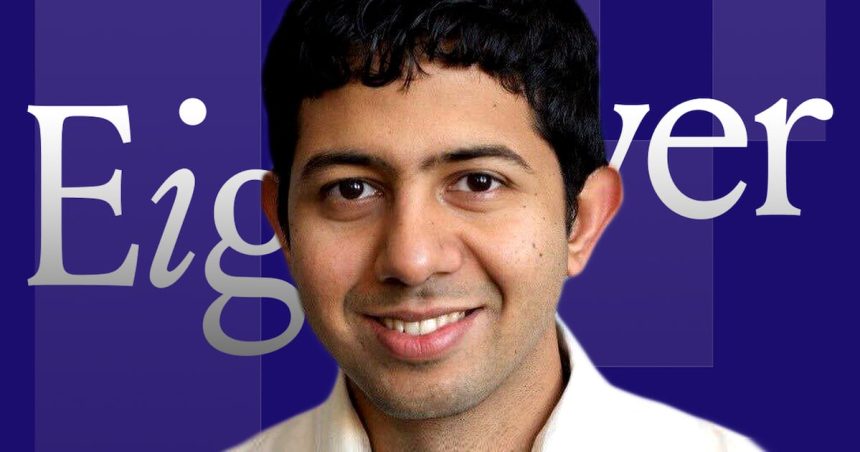In an exclusive interview, Kannan explained how the restaking protocol's hot start was difficult to manage. Controversies ran thick and fast during Eigenlayer's first six months. Now he's talking about the lessons learned and Eigenlayer's next move.
Within a year of its June 2023 launch, EigenLayer dreamed up the initial crypto projects.
Ethereum Restocking Venture Accumulated It has nearly $20 billion in user deposits and a $100 million investment from its parent company VC powerhouse a16z.
Even better, the project quickly proved its worth: according to founder Sriram Kannan, more than 100 companies have flocked to EigenLayer, including crypto exchanges. Kraken and bridge developer Layer Zero Labs.
But EigenLayer may have come too far, too fast, as the project continues to respond to a series of controversies, including allegations that it tried to buy off a pair of influential — and often critical — crypto researchers.
“Somehow, it's at the center of Ethereum,” says founder Sriram Kannan News In a wide range of interviews. “We're not ready to be the center of some major ecosystem.”
Unequal attention
EigenLayer now has $11 billion in deposits. It may have originated in academia with the ambition to create a “free market for decentralized trust,” but its rollout has become a classic tale of the pitfalls of overnight success.
Taking a breather after the project got off to a hot start, Kannan discussed his first attempt at building a crypto company and what's next for EigenLayer.
EigenLayer makes it easy to launch certain protocols, a process called restaking that runs and secures computers and the cryptocurrency Ether.
Join the community to get our latest articles and updates
At a conference in Istanbul last year, Kannan likened the concept to a military alliance.
“Cities don't have armies, nations have armies. Sometimes even several nation states coordinate to form alliances that actually work together,” he said.
“It's exactly the same phenomenon. Shared security is definitely better.
'I'm amazed that we have EF researchers… take six-, seven-figure compensation packages from protocols.'
– Lefteris Karapetsas, Rotki
Some Ethereum researchers were quick to declare EigenLayer a breakthrough. But some have warned that too many services risk destabilizing the blockchain by relying on a single batch of Ether for their security.
In other words, if a project built on top of an EigenLayer fails, it takes the replaced Ether with it. Or, to extend Kannan's analogy: if a city fails, an army can be taken with it.
In short, critics fear it could lead to cascading failures that would ultimately harm Ethereum itself.
To ease concerns, EigenLayer launched features one at a time over a period of months. Later this year, it will change its security model to limit contagion in the event that certain applications fail.
But an attempt to highlight safety has not gone well.
Earlier this year, it brought on prominent Ethereum Foundation researchers Justin Drake and Dankrad Feist as advisors.
They are appointed to address the risks associated with the relocation to Ethereum. And they're well compensated — Drake's payout could one day be worth millions, he said.
A profitable relationship
The lucrative relationship wasn't revealed until a crypto influencer wrote about it on social media.
Lack of transparency is not the only violation of DeFi values. This has also prompted criticism that the Ethereum Foundation is turning a blind eye to conflicts of interest.
“I'm very surprised that we have EF researchers, people guiding protocol development, taking six- and seven-figure compensation packages from protocols,” said Lefteris Karapetsas, founder of Rotki. wrote that On X.
“Even though you promised Pinky that you wouldn't allow it to cloud your judgment and that it was impossible to do in a personal capacity.”
The main benefit
Both Drake and Feist say they won't settle for Eigenlayer's money.
Feist says EigenLayer is “a major advantage for Ethereum” — if done right.
“I believe the current leaders want to do that and I plan to hold them accountable for that,” he said. wrote that In X. “If I believe this is no longer the case I will not hesitate to speak out and/or resign my position.”
Drake has promised to channel all the money he earns from EigenLayer into other Ethereum projects in the form of grants or investments.
“I am prepared to terminate an advisor at any time, e.g. EigenLayer should go in a direction that I feel is against the interests of Ethereum,” he wrote.
The value of crypto deposited into EigenLayer has hit $20 billion at its peak.
According to Cannon, EigenLayer delayed announcing the partnership at the request of the Ethereum Foundation, which wanted to disclose the relationship itself.
But crypto influencer Jordan Fish, better known as Kobe, He pressed its hand forcefullyEthereum Foundation researchers wrote in X that EigenLayer was “taking life-changing $ packages” from projects that “had conflicting incentives with Ethereum” before naming it.
Drake Confirmed A relationship on his website and in X claims he was paid crypto that would eventually be worth millions of dollars.
Feist did the same Said His salary was only “a considerable amount of tokens”.
“Even though people think it's some kind of destructive thing. It's not,” Kannan said.
Completely transparent
“It's completely transparent, we talked to the Ethereum Foundation. The Ethereum Foundation asked us not to publicize it. … They said, 'We will promote it in the right way.'
The Ethereum Foundation is not back News' Request for comment.
But according to Kannan, the payoffs are also thanks to a pair of researchers who have already done much to shape the direction Eigenlayer took.
'We want to pay back the people who actually invested and created these ideas.'
– Sriram Kannan, Eigenlayer
“EigenDA is a protocol built on the ideas of Dankrad and Justin,” said Cannon, referring to the EigenLayer term for projects built on top of the EigenLabs-built active authentication service.
“We want to pay back the people who actually invested and created these ideas.”
Before the issue was settled, another controversy reached its climax.
Vesting of tokens
A CoinDesk An article in August reported that EigenLabs had pressured partner companies to send a cut of any newly issued tokens to their employees.
Aizen Labs has denied the allegations. Then, in September, some critics flagged what they feared were early, deep-pocketed EigenLayer investors who could avoid vesting their tokens, saying the company feared too much.
“Being right in crypto is not enough. Basically, when you want to build trust, you have to be demonstrably right, which is a very, very high bar,” said Kannan. “It's really hard, it's not easy. And for a project of our size we have a disproportionate amount of attention.
To meet that challenge, Kannan said, the company is devoting more manpower to improving its transparency standards.
“If we want to become the cohesive engine of humanity, it must be able to withstand this [scrutiny],” he said.
The trifecta
Once skeptical of crypto as a speculative bubble, he now speaks like a true believer, often using soaring rhetoric.
“I was at a dinner with a US congressman, and he asked, 'Can you tell me why you're in crypto?'” Kannan recalled.
“Many of the founders of the DeFi protocol, they all said, 'Improve the economy and prevent inflation,' which are all things we know and love. But what I'm saying is, 'This is the biggest upgrade to human civilization since the Constitution.'
Kannan, with a passion for peer-to-peer networks, got into crypto in 2018.
He authored academic papers on the topic and eventually set out to create his own blockchain, known as the “Trifecta.”
But he could not raise the money.
If he successfully attracts VCs, launching blockchain will be easier. It would also be easier if new blockchains didn't need their own network of distributed computers. That is, if he can use computers already running Ethereum.
“The eigenlayer was conceived as a mechanism to solve my own problem,” he says.
Alex Gilbert is a DeFi correspondent News. You can reach him at [email protected].







